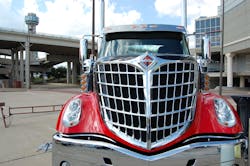Navistar reported a pre-tax loss of $100 million in the third quarter this year due to lower sales of its truck and engine products, along with $16 million charges related to what the company called “engineering integration” and $10 million in non-conformance penalties (NCPs) assessed on its engine models that do not comply with the Environmental Protection Agency’s (EPA) 2010 emission standards.
However, the Lisle, IL-based OEM managed to offset those losses via a $196 million tax benefit, allowing Navistar to post net income of $84 million in the third quarter – a far cry, though, from the $1.4 billion in profits posted by the truck and engine maker in the third quarter of 2011.
Navistar also said its revenues decline 6% during the third quarter this year to $3.3 billion driven lower net sales in the company's U.S. and Canada truck and engine segments, primarily due to lower military sales and reduced engine volumes in South America, respectively. Navistar added that sales of its Class 6 and 7 medium trucks fell 22%, which was partially offset by a 32% increase in school bus volumes.
"Clearly we are not pleased with these results," said Lewis Campbell, Navistar’s newly-installed chairman and CEO, in the company’s third quarter earnings statement – though he stressed the company is “already working” on a plan to restoring its North American truck, engine and parts businesses to what Campbell termed their “market leader” positions.
“I believe we have good line of sight and a keen sense of urgency for moving forward,” he added. “With a laser focus on getting our quality right and hitting our clean engine launch dates, combined with actions to maximize cash flow and improve our balance sheet, I believe we can accelerate the pace of progress to deliver significant improvements during the next 12 to 18 months.”
However, several analysts are concerned about whether Navistar can achieve a turnaround within that timeframe – in no small part because the company is again under investigation by the Securities & Exchange Commission (SEC).
“While we have been positive on Navistar’s shares for the last three to four years due to the low valuation and management's bold strategy to produce an innovative product … it became apparent in 2012 that EGR [exhaust gas recirculation] was not going to meet the EPA 2010 standard,” noted Walter Liptak, an analyst with Barrington Research.
“As Navistar’s engine strategy has changed to SCR [selective catalytic reduction], we are hopeful that the company is now on the right engine technology path,” he added. “However, with a new SEC inquiry, declining North American truck orders, and near-term earnings impaired, we cannot afford Navistar our firm’s highest rating.”
Liptak also said that Navistar’s deal-in-progress with Cummins Inc. for SCR aftertreatment systems and to offer SCR-equipped ISX 15 engine for its trucks is a “good move,” he still expects that Navistar’s transition from EGR to SCR to be “a painful one.”
“We suspect that the ISX15 will help Navistar bridge the gap of time needed to get its heavy truck engines certified by the EPA,” he pointed out. “The issue is the EPA engine credits are running out well in advance of Navistar having EPA emissions certification.”
The EPA also raised the cost of said penalties within its recently published nonconforming manufacturer final rule.
For engines at the upper NOX (oxides of nitrogen) limit of 0.50 grams per brake horsepower hour (g/bhp-hr), the penalty is $3,775 for each model year 2012 engine, the agency said. However, EPA stressed that manufacturers would pay a lesser penalty if the NOX emissions are lower. For example, the penalty for a 2012 engine with NOX emissions at 0.30 g/bhp-hr would fall to $1,259 per engine unit.
Many rival OEMs had argued in comments submitted to the EPA that such penalties should have been much higher. Paccar, for instance -- which builds Kenworth and Peterbilt trucks -- said the NCP for engines surpassing the 0.50 g/bhp-hr limit should be at a minimum $14,378 per unit, while Cummins argued for penalties of $8,100 per heavy-duty diesel engine and Mack Trucks said that $1,919 should be added to the EPA’s final penalty figure– for a total NCP of $5,694 per engine.
About the Author
Sean Kilcarr
Editor in Chief
Sean Kilcarr is a former longtime FleetOwner senior editor who wrote for the publication from 2000 to 2018. He served as editor-in-chief from 2017 to 2018.
